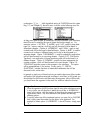
Page 3-1
Chapter 3
Calculation with real numbers
This chapter demonstrates the use of the calculator for operations and functions
related to real numbers. Operations along these lines are useful for most
common calculations in the physical sciences and engineering. The user should
be acquainted with the keyboard to identify certain functions available in the
keyboard (e.g., SIN, COS, TAN, etc.). Also, it is assumed that the reader
knows how to adjust the calculator's operation, i.e., select operating mode (see
Chapter 1), use menus and choose boxes (see Chapter 1), and operate with
variables (see Chapter 2).
Checking calculators settings
To check the current calculator and CAS settings you need to just look at the top
line in the calculator display in normal operation. For example, you may see
the following setting: RAD XYZ DEC R = ‘X’
This stands for RADians for angular measurements, XYZ for Rectangular
(Cartesian) coordinates, DECimal number base, Real numbers preferred, =
means “exact” results, and ‘X’ is the value of the default independent variable.
Another possible listing of options could be DEG R
∠Z HEX C ~ ‘t’
This stands for DEGrees as angular measurements, R
∠Z for Polar coordinates,
HEXagesimal number base, Complex numbers allowed, ~ stands for
“approximate” results, and ‘t’ as the default independent variable.
In general, this part of the display contains seven elements. Each element is
identified next under numbers 1 through 7. The possible values for each
element are shown between parentheses following the element description. The
explanation of each of those values is also shown:
1. Angle measure specification (DEG, RAD, GRD)
DEG: degrees, 360 degrees in a complete circle
RAD: radians, 2
π radians in a complete circle
GRD: grades, 400 grades in a complete circle


















